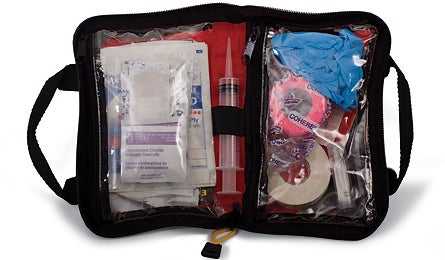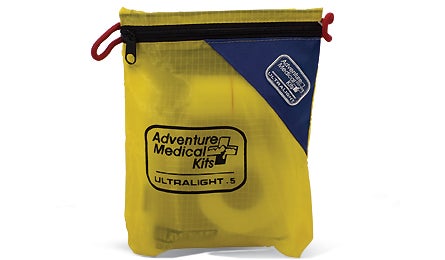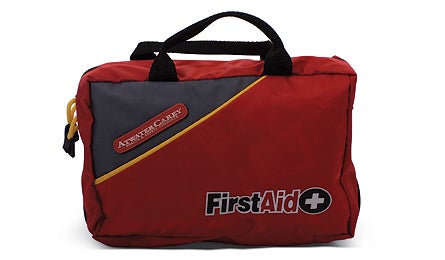March 2008 Essentials Review: First-Aid Kits

Atwater-Carey Adventure Backpacker

Adventure Medical Kits Ultralight & Watertight .5

Atwater-Carey Adventure Expedition
Soloists
Adventure Medical Kits Ultralight & Watertight .5
Small isn’t just beautiful, it’s also smart. That’s because lightweight, compact kits are more likely to fit in your overstuffed backpack–and not be left behind in your closet or car. This pint-size kit is the ideal companion for the all-weather solo hiker who wants basic wound-management supplies, but not SAM splints, scissors, or syringes. It contains enough bandages, gauze, and tape to stop severe bleeding, as well as blister-salving adhesive strips and moleskin. The construction is watertight and durable; the internal, zip-top Aloksak bag kept the contents dry in our testing and didn’t pop when we stepped on it. $17; 4 oz.; adventuremedicalkits.com
Dayhikers
Atwater-Carey Light & Dry LD2
Even dayhikers need the added safety margin of a lightweight first-aid kit, especially if their survival gear is limited to a few trail bars and an extra fleece. The LD2 fits the bill for both soloists and small groups on dawn-to-dusk jaunts. It contains more bandages than the AMK .5, plus medical tape, a gauze roll, and wound-closure strips. It also comes with medicine to soothe muscle aches, bug bites, and upset stomachs. Spare room in the nylon pouch makes it easy to load additional items specific to your route or group size, while an internal zip-top bag keeps bandages dry. Pack too full? Bring this kit anyway–by clipping its external loops to a side strap or daisy chain. $20; 5 oz.; atwater-carey.com
Weekends
Best Buy
Atwater-Carey Adventure Backpacker
Like the midsize sedan that seats five but still squeezes into compact-car parking spaces, this kit is spacious enough to carry everything most hikers need, yet small enough to shove in your pack’s top lid. Zipped inside the durable nylon exterior are two pouches with plastic windows, which make it easy to find what you need–whether it’s ibuprofen tablets or a 5×9-inch sterile pad. Adhesive bandages are double-bagged to prevent soaking, and the kit contains multiday trip essentials like antibiotic ointment, safety pins to secure bandages or repair gear, and a small syringe to irrigate a wound or dislodge eye irritants. Save weight by studying the 116-page booklet at home–and leaving it there. $25; 11 oz.; atwater-carey.com
Groups
Atwater-Carey Adventure Expedition
Put disaster on hold with this kit, which unzips into three separate pouches with see-through plastic covers. Stashed inside are 76 first-aid items, including an ACE bandage, 10 yards of adhesive tape, a large triangular bandage (for making a sling or wrapping a head wound), scissors, an antiseptic sponge, and iodine water-treatment tablets. Bandages are double-bagged, and all items are easy to find, sort, and put away. You’ll want to add more pain pills (only four doses of ibuprofen are included), but not gauze (it comes with 11 pads). Clear out some of the excess items, and you’ll have enough room for a pair of Epi-pens, more vitamin I, and a backup headlamp. $50, 1 lb.; atwater-carey.com
Customize Your Kit
5 emergency extras our safety experts recommend
- Survival blanket and firestarter kit (butane lighter and cotton balls soaked in petroleum jelly packed in a film case) to survive a night out
- A #16 blunt-point plastic/canvas needle and #69 bonded nylon thread to repair rips in clothes, packs, and tents
- Brunton’s 9067 bubble compass ($5; .5 oz.; brunton.com) and the Survival S.O.S Whistle ($3; .3 oz.; campmor.com); find yourself, or help others find you
- Hand sanitizer and a lightweight blade like Kershaw’s Two Can knife (.9 oz., page 148) to make sterile incisions
- Bandanna to make a sling, wrap an ankle, or bandage a wound